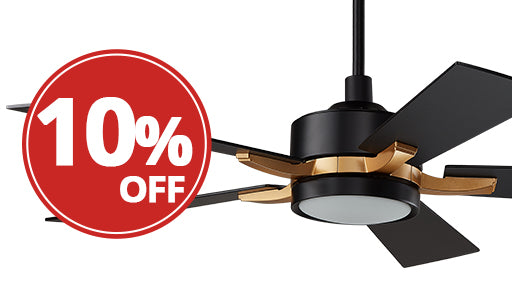Summer is looming and that often means a battle between you and your home’s air control. The most obvious solution is to invest in an air conditioner, but did you know that this takes up 12% of your home’s energy? Plus, some homes cannot be equipped with an air conditioner.
Enter smart fans. Today, ceiling fan designers are creating new models featuring cutting edge technologies to make climate control simple, effective, and affordable.
Plus, from an environmental standpoint, smart fans are so much better than air conditioners. That’s because air conditioners release millions of metric tons of carbon dioxide into the air. Yuck!
Want to learn more about energy-efficient ceiling fans and how they can help you save money (and the planet)? Keep reading.
How Smart Fans Work
Smart house ceiling fans work like your typical ceiling fan, except that they’re programmed to know when to spin and when to keep the air still. That means you can schedule a certain temperature for it to adjust to or can plan for when the fan should work.
More developed options feature occupancy sensors and geolocation settings that ensure the fan is only running when required, saving you money on energy bills in the long run.
Unlike your usual ceiling fan where the sole connection is a pull wire or cables within the walls, smart fans use Wi-Fi or Bluetooth.
The convenience with this is that it means you can remotely control your smart ceiling fans using your iOS or Android mobile phone. That’s even if you’re away from the phone.
Those that prefer their original ceiling fan can use a device that allows you to transform an existing fan into a smart version. This works by installing a small device inside the fan using a hub along with the existing motorized blind IR remote control. Or, you can change your wall switch with a Z-Wave or Zigbee option that links and controls the ceiling fan.
As you can see, smart fans make an excellent alternative to air conditioning. While air conditioning makes us feel comfortable, it can be expensive and it’s also bad for the environment. Smart fans offer an energy-saving solution to help make rooms feel either warmer or cooler, and nowadays they’re becoming more and more sophisticated to help you save money and reduce air pollution.
While air conditioners are only useful during the summer months, smart fans are versatile and can lower heating bills during the colder months. That’s because smart fans have a winter feature that fights heat stratification.
Saving Money With Smart Fans
Smart ceiling fans vary by price depending on the brand and how sophisticated they are. Generally, popular ceiling fans will retail at around $700. More affordable options may cost around $300 apiece.
While this can sound pricey, remember that smart ceiling fans are an investment. In the long run, think about how much money you’ll save on energy bills.
So why do smart ceiling fans range so greatly in the price? For a model on the lower end, you should expect lower quality with fewer features. The app experience may be less streamlined too, and perhaps the customer service is slower.
If you don't want to spend a lot on a new fan, remember that you can always upgrade your current ceiling fan to a smart fan. You can do this by purchasing a z wave switch, infrared remote hub connection, or a hardwired Wi-Fi add-on.
Smart fans are a great way to save energy for your home and wallet. Instead of leaving your fans on all day, the clever devices use integration with temperature sensors to ensure that they’re only running when the temperature of the room reaches a certain amount.
If you need a new fan and you’d like to save some cash and have more control over the climate of your home, then consider a smart ceiling fan. The cost isn’t too much more than a regular fan, and you'll soon find that you save the money from paying less on energy bills.
Controlling Smart Fans
As well as being affordable and great for the environment, an energy-efficient fan is easy to operate too. Voice control is a popular method of operation. All you need to do is make a simple call to Alexa, Google Home, or Siri to adjust the fan.
You can also use infrared remote control if you don’t have any of the smart home brands as mentioned. Every smart ceiling fan will come with a classic infrared remote control to use, but it must be directed at the fan if you want to control it.
As mentioned, you can also use a Z-wave wall switch to control the smart fan if you already have this installed in your wall.
The most convenient option is a smartphone app. By having an easy-to-use app on your device, this means you can control your smart fan wherever you are. So, if you fancy coming home to a nice cool room after work, you can switch your fan on straight from the office.
Ready to Invest in Smart Fans?
If you want to save money on energy bills as well as benefiting the environment, swapping to smart fans is the sustainable way forward.
Not only that, but you’ll have more control over your environment using innovative features. It’s a win-win situation!
If you think a smart ceiling fan is right for you and your home, we’re here to help. Have a look at our best-selling fans here.















